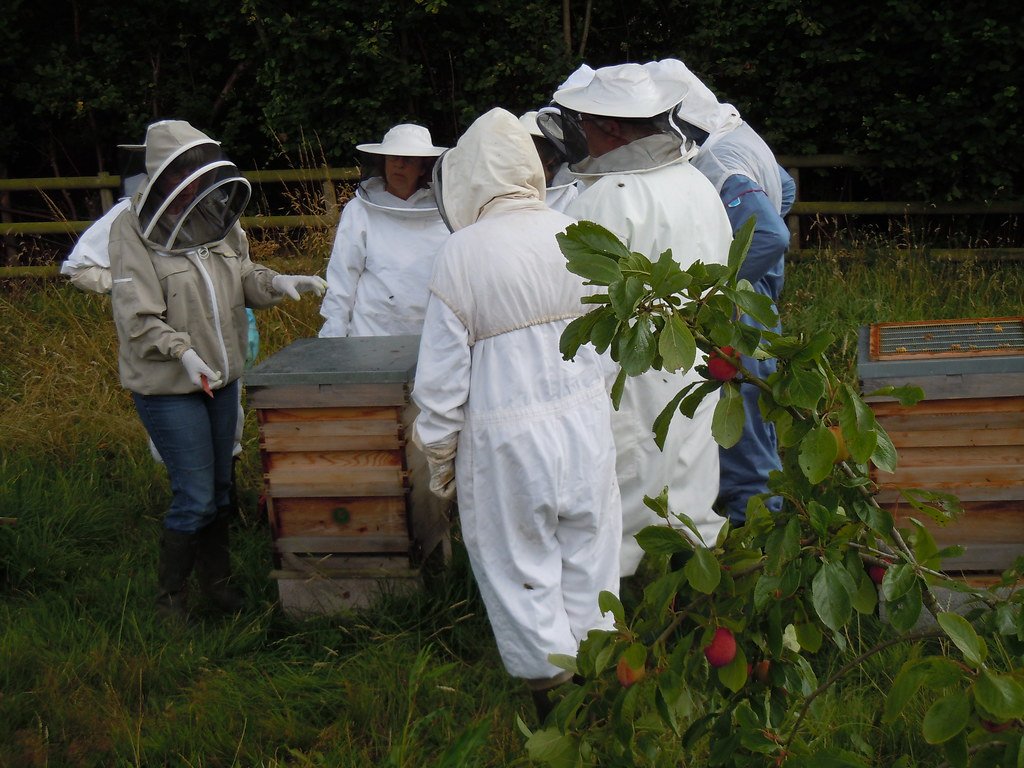Nestled amidst the sprawling concrete jungle, urban hives stand as resilient symbols of nature’s determination to adapt and survive in an increasingly artificial world. These oases of buzzing activity, where bees tirelessly go about their pollen-gathering missions, are not immune to the whims of weather. From scorching summer heat to bone-chilling winter frost, the impact of weather on these tiny metropolises is both fascinating and crucial. So, let us delve into the intricate web of climatic nuances that influence the ceaseless hum of an urban hive, uncovering the delicate balance between Mother Nature’s unpredictability and the indispensable role these honey-producing havens play in our ecosystem.
Table of Contents
- The Impact of Weather: Understanding the Dynamics and Effects on Urban Hives
- Enhancing Hive Productivity: Optimizing Environmental Conditions for Urban Beekeeping
- Weather Resilience Strategies: Building a Strong and Sustainable Urban Hive
- Safeguarding Urban Hives: Mitigating Weather-related Risks and Challenges
- Weather-Proofing Your Hive: Practical Tips for Weather Management in Urban Beekeeping
- Q&A
- Concluding Remarks

The Impact of Weather: Understanding the Dynamics and Effects on Urban Hives
Weather plays a crucial role in the dynamics of urban hives, influencing their productivity, health, and overall well-being. Understanding the impact of weather conditions on these buzzing ecosystems can help beekeepers and researchers make informed decisions to support and protect urban bee populations.
Temperature:
The temperature is a key factor affecting honeybees. Extreme heatwaves or sudden temperature drops can pose risks to their survival. During periods of high temperatures, bees might struggle to regulate the hive’s internal temperature, leading to stress and increased energy consumption. Conversely, chilly weather can inhibit foraging activities, hinder colony development, and even cause queen bees to temporarily cease laying eggs. Maintaining a stable temperature within the hive is therefore crucial for the productivity and long-term sustainability of urban hives.
Precipitation and Humidity:
Just as humans seek shelter during heavy rain, urban bees also face challenges when it comes to precipitation. Rain and excessive humidity can prevent honeybees from venturing out for nectar and pollen, disrupting their foraging routines and reducing the availability of food sources. Moreover, damp conditions can promote the growth of fungi and pathogens, potentially exposing bees to various diseases. Beekeepers must be vigilant during wet periods to ensure the hives remain well-ventilated and protected, minimizing the risk of waterlogged or diseased colonies.
Seasonal Changes:
The changing of the seasons significantly impacts urban hives. As flowers bloom and tree buds burst, the availability of nectar and pollen fluctuates, influencing the nutritional resources accessible to bees. Beekeepers need to be aware of these seasonal variations and adapt their management practices accordingly. For instance, providing supplemental feeding during lean periods ensures the nutritional needs of the colony are met, especially during early spring or late fall when natural food sources may be scarce.

Enhancing Hive Productivity: Optimizing Environmental Conditions for Urban Beekeeping
Beekeeping in urban areas presents unique challenges due to the limited availability of forage, potential exposure to pollutants, and fluctuating environmental conditions. However, by optimizing the environmental conditions, beekeepers can create a thriving hive that maximizes productivity. Here are a few key strategies to enhance hive productivity in urban beekeeping:
- Choosing the right location: Select a location that provides abundant access to diverse sources of nectar and pollen. Urban gardens, parks, and rooftop gardens can offer a rich variety of flowering plants, ensuring a continuous food supply for the bees.
- Proper hive ventilation: Adequate ventilation is crucial for regulating temperature and humidity within the hive. Ensure that your hive has proper ventilation by using screened bottom boards or ventilation holes. This helps in reducing moisture buildup and preventing the growth of harmful pathogens.
- Implementing water sources: Bees require a water source near the hive to stay hydrated. Place shallow water dishes or create a small artificial pond with floating plants close to their forage areas. This will help prevent them from seeking water in potentially contaminated sources.
- Reducing exposure to pesticides: Urban areas often have increased pesticide usage. Educate and collaborate with the local community to reduce pesticide application, and encourage organic gardening practices. By minimizing exposure to pesticides, you can safeguard the health of your bees and enhance productivity.
Remember, bees are highly adaptable creatures, and with thoughtful attention to their surroundings, urban beekeepers can create ideal conditions that foster hive productivity and contribute to the overall well-being of these remarkable pollinators.

Weather Resilience Strategies: Building a Strong and Sustainable Urban Hive
As our cities grapple with the increasingly unpredictable and extreme weather conditions brought on by climate change, it has become imperative to develop effective strategies that make our urban spaces resilient. The concept of building a strong and sustainable urban hive goes beyond just adapting to these weather challenges; it involves creating a harmonious and interconnected urban ecosystem that can withstand and thrive in the face of adversity.
One crucial aspect of weather resilience strategy is the implementation of green infrastructure. Incorporating green spaces, such as parks and rooftop gardens, not only enhances the aesthetic appeal of our cities but also helps in reducing the heat island effect and improving air quality. Green roofs, in particular, are highly effective in providing insulation, reducing stormwater runoff, and mitigating the urban heat island effect.
Another important consideration is the construction of resilient buildings and infrastructure. Utilizing sustainable materials and incorporating advanced technologies can greatly enhance the durability and energy efficiency of our urban structures. Implementing techniques like passive cooling and solar shading systems can help regulate indoor temperatures while minimizing reliance on energy-intensive cooling systems. Additionally, the use of smart grids and renewable energy sources can contribute significantly to the overall resilience of an urban hive.
- Integrate green spaces and rooftop gardens to combat heat island effect and improve air quality.
- Construct buildings using sustainable materials and advanced technologies for enhanced durability and energy efficiency.
- Implement passive cooling and solar shading systems to regulate indoor temperatures and reduce reliance on energy-intensive cooling systems.
- Utilize smart grids and renewable energy sources to enhance overall resilience.

Safeguarding Urban Hives: Mitigating Weather-related Risks and Challenges
Urban beekeeping has become an increasingly popular practice, but it’s not without its challenges. Weather-related risks can pose a threat to the health and productivity of urban hives. However, with proper mitigation strategies in place, beekeepers can safeguard their hives and ensure the well-being of their buzzing communities.
Effective siting: Choosing the right location for urban hives is crucial. Look for areas that provide some protection from the elements, such as buildings or trees that offer windbreaks. It’s also important to consider the availability of natural forage and a diverse range of flowering plants throughout the seasons.
Weatherproofing: Extreme weather events can wreak havoc on urban hives, especially during storms or harsh winter conditions. Ensuring that hives are well insulated and constructed with strong materials can help withstand these challenges. In addition, providing windbreaks, such as fences or barriers, can reduce wind exposure and maintain hive stability.
Emergency provisions: In the face of unpredictable weather patterns, it’s essential for beekeepers to be prepared. Having emergency supplies like extra hive components, feeders, and insulation materials on hand can help mitigate unexpected risks. Regular monitoring of hive conditions and taking proactive measures ahead of severe weather can ultimately save urban hives from potential destruction.
Disease prevention: Weather-related stress can weaken the immunity of urban honeybees, making them more susceptible to diseases. Beekeepers should closely monitor hive health, conduct regular inspections, and promptly address any signs of disease. Proper hygiene practices, including hive cleaning and regular queen replacement, are also crucial to maintaining the overall resilience of the urban hive population.
Safeguarding urban hives against weather-related risks and challenges requires a combination of strategic planning, ongoing monitoring, and a proactive approach. By employing these practices, beekeepers can ensure that their buzzing communities thrive even in the face of unpredictable elements.
Weather-Proofing Your Hive: Practical Tips for Weather Management in Urban Beekeeping
In urban beekeeping, weather management is crucial for the well-being and productivity of your hive. Bees are highly sensitive creatures, and extreme weather conditions can have a significant impact on their health and overall success. To ensure your hive is weather-proofed and ready to thrive, here are some practical tips:
1. Providing Adequate Shelter
Creating a suitable shelter is the first line of defense against harsh weather. Invest in a high-quality hive that is sturdy and well-insulated. Additionally, consider placing your hive in a sheltered area, such as a garden or against a wall, to protect it from strong winds. Make sure the hive is securely assembled to prevent leaks or drafts that could compromise its interior.
2. Ventilation to Prevent Overheating
While shelter is essential, proper ventilation is equally important. Bees generate heat within the hive, and during hot summer months, they can easily overheat. Ensure your hive has adequate ventilation, such as screened bottom boards or ventilation holes, to prevent the hive from becoming too stuffy. Adequate ventilation not only helps control the temperature but also reduces the risk of condensation and excessive moisture.
3. Rain and Wind Protection
Heavy rain and strong winds can pose a threat to your hive. Consider using a top cover, such as a sturdy rainproof roof or an angled canopy, to shield the hive from direct rainfall and prevent water from entering the hive. Additionally, installing windbreaks around your apiary, such as shrubs or fences, can provide extra protection against gusts of wind while still allowing adequate airflow.
Remember, weather-proofing your hive goes beyond just protecting the bees. It also helps maintain a stable environment for them to flourish and produce honey. By implementing these practical tips, you’ll be well on your way to ensuring the success of your urban beekeeping venture!
Q&A
How does weather affect the health and productivity of an urban beehive?
Weather plays a crucial role in determining the health and productivity of urban beehives. Bees are highly sensitive to temperature, humidity, and rainfall, which can affect their foraging and pollination capabilities, as well as the growth and survival of their colonies.
What is the impact of temperature on urban beehives?
Temperature fluctuations can have a significant impact on urban beehives. Extremely hot weather can cause bees to overheat, resulting in loss of foraging efficiency and even death. Conversely, chilly temperatures can impede the bees’ ability to fly, reducing their foraging range and making it difficult to gather nectar and pollen.
How does humidity affect the behavior of urban bees?
Humidity levels affect the air density, which directly impacts bees’ flying abilities. High humidity can make it harder for bees to maneuver, reducing their ability to navigate quickly between flowers and return to the hive efficiently. Furthermore, excess humidity may promote the growth of fungi and diseases within the hive.
What impact does wind have on urban beehives?
Strong winds can pose a challenge for urban beehives. Not only can gusts disorient bees, making it harder for them to find their way back to the hive, but they can also lead to damage of the hive structure and increase the risk of hive abandonment. Windy conditions can also hinder successful mating flights of queen bees.
How does rainfall affect urban beehives?
Rainfall has both positive and negative impacts on urban beehives. While it provides a crucial water source for bees, excessive or prolonged rainfall can make foraging difficult and decrease the availability of nectar and pollen. Additionally, wet conditions can increase the risk of diseases and infections within the hive.
How does extreme weather events, such as storms, impact urban beehives?
Extreme weather events like storms can have devastating effects on urban beehives. Strong storms can damage the hive infrastructure, disrupt foraging patterns, and disorient bees, leading to lost productivity and potential colony loss. Additionally, heavy rainfall and flooding can lead to waterlogged hives, increasing the risk of disease and mortality.
What can urban beekeepers do to mitigate the negative impacts of weather?
Urban beekeepers can take various measures to minimize the negative impacts of weather on their hives. These may include providing shade to protect from excessive heat, windbreaks to reduce the impact of gusts, and ensuring proper hive insulation to safeguard against extreme temperatures. Regular monitoring and swift action in response to adverse weather conditions are key to maintaining healthy and productive urban beehives.
Concluding Remarks
As we conclude our exploration of the impact of weather on your urban hive, we are reminded of the delicate dance between nature and urbanity. From the buzzing heart of the city to the ethereal beauty of changing seasons, the weather affects our bees in profound and often unforeseen ways.
Through the sun’s gentle touch and the rains’ refreshing cascade, our urban hive stands as a resilient testament to the adaptability of these remarkable creatures. It is an intricate symbiosis where urban dwellers and diligent bees coexist, both shaping and being shaped by the ever-changing atmospheric tapestry.
As the winds of change blow through the streets, we witness the transformative power of weather on our urban ecosystem. In the depths of winter’s chill, our bees huddle together, relying on their wings to generate warmth within their clustered community. They brave the elements, complete their essential tasks, and ensure the prosperity of generations to come.
When the rejuvenating showers of spring arrive, our urban hive awakens to a world abloom. The cityscape transforms into an urban Eden, offering nectar-rich blossoms and vibrant greens. The industrious bees emerge, their wings beating with purpose and their honeycombs brimming with new life. With every buzz, they contribute to the ebb and flow of urban pollination, revitalizing our concrete jungles.
Yet, as summer’s heat scorches the asphalt, our bee colonies face a different set of challenges. The soaring temperatures and scarce water sources demand swift action from the meticulous keepers of the hive. Strategically placed water stations and shade-giving vegetation become crucial lifelines. It is during these sweltering days that we witness the collective resilience of these urban warriors, for they persevere and sustain their colonies against all odds.
Autumn unfolds its captivating symphony, and the urban hive once again adapts. As the leaves change their hues and the air turns crisp, our bees shift their focus to the final harvest. The honey stores are meticulously packed away, serving as a lifeline during the hibernation of the colder months. The changing weather becomes a somber reminder of the cyclic nature of existence, where the hive prepares for the stillness that winter brings.
In the grand tapestry of urban life, the impact of weather on our hive is one of interdependence. It is a constant reminder that, amidst the chaos of city dwellings, the delicate balance between nature and human-made spaces must be nurtured. As the seasons come and go, may we forever hold reverence for the hidden heroes who tirelessly work amidst the ever-changing skies, for they are the unsung guardians of a harmonious coexistence.
As an affiliate, my content may feature links to products I personally use and recommend. By taking action, like subscribing or making a purchase, you’ll be supporting my work and fueling my taco cravings at the same time. Win-win, right?
Want to read more? Check out our Affiliate Disclosure page.